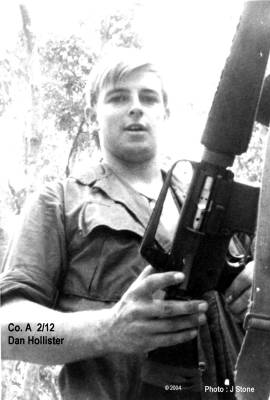
The Final Mission
As I walked up the path to the ridge, my anxiety was mounting. I wasn’t really sure if some of my army buddies were dead or alive, but I had to find out. There were rumors the casualty numbers were high so I tried to prepare my self for the worst. I had attempted to ready myself for a very emotional time but as usual no preparation ever seemed to help. I had those same anxieties that I had so many times before. I was recalling the intense activity of past missions—the gunfire—the sound of the firefights—the scenes of discarded field equipment from the casualties—men on stretchers—the sound of the dust-off choppers landing to evacuate the wounded. I constantly thought about the casualties after a battle. Once they were on that dust off chopper, I usually never got to see them again and it left me wondering what the extent of their injuries were. This time I was determined to find out.
While walking toward the top of the hill, I passed some people on their way back. No one was talking. I could tell some had been crying, making their sorrow obvious. The solemn look on many faces made me wonder if I could handle any more dead or wounded without crying myself. Every step I took I was feeling more apprehensive of what was awaiting me.
As I came over the ridge, I was no longer imagining things of past missions. This scene was different There was no gunfire—no artillery—no choppers overhead—all was quiet. There were no men on stretchers. There was no discarded field equipment lying around. The battle was over—the war was over. It was the present. The year was 1989. The month was August. Twenty-one years had passed since I left Vietnam, but I guess it really never left me. The memories and feelings were still there. It just took this visit to the Vietnam Moving Memorial Wall to recall them.
The Moving Vietnam Memorial Wall, a half size replica of the Wall in Washington had come to my hometown. I ventured to find the fate of my friends and used this opportunity to search for some answers. As I looked at the wall sections, I was in awe. I found it hard to believe there were so many casualties. The number was 58,228. "IN HONOR OF THE MEN AND WOMEN OF THE ARMED FORCES OF THE UNITED STATES WHO SERVED IN THE VIETNAM WAR. THE NAMES OF THOSE WHO GAVE THEIR LIVES AND OF THOSE WHO REMAIN MISSING ARE INSCRIBED IN THE ORDER THEY WERE TAKEN FROM US.”
The names on the wall were not in alphabetical order so I was going to need help finding my friends. I found someone in authority and asked, “I’m looking for some guys and was wondering if you could help me locate them.” The lady I was talking to was a visitor assistant. She was there to help people find the names on the wall.
“Were they friends?”, she asked.
“Yes”, I said, “They were guys I served with in Vietnam. I know I’m going to find some honored here, but I’m not really sure what happened to some of the others. I had personally witnessed some getting wounded, but I was never really sure of the extent of their wounds or the details afterward. The last time I saw some of these guys, they were on a stretcher getting carried to a chopper. They were abruptly taken away and I never had a chance to say good-bye. I’d like to find out which ones made it home.”
Made it home—a term I felt comfortable with. Saying dead or alive felt so callous—so insensitive. Saying “made it home” made it so much easier for me to say and distinguish those who made it home alive and those who didn’t.
As I opened my diary to the list of names, I paused at the second page. At the top was the following:
“In memory of the times and friends.”
I turned some more pages and looked down at the list of names that I recorded so many years earlier. I had that same peculiar feeling—that same feeling of disbelief each time I read the names of those I knew were KIA (killed in action)—the same feeling that some KIA’s on my list were a mistake. Like it wasn’t true. Maybe because I could still see their faces—hear their voices and pictured the way they laughed. As many times as I had read this list of KIA names, I always had trouble believing it.
Finally after all these years I was about to get some answers. As I read the names one by one, my feelings were just below the surface of my composure. The lady searched for each name using an alphabetical index. Many of the names were not found—confirming they made it home. Each one she found, I wrote the panel location next to each name in my diary. When the list was complete, I went to the wall and located each name. As I touched each name, I said a long-overdue goodbye to each one of them. I said goodbye to the men that were lost in the surprise ambush that occurred on October 25, 1967—Bobby Bonin, Art Roesler, Gordie Graham, Alex Houston and my joking buddy—Carl S. Thoren-Thomsen. I also said farewell to Don Kreuscher and my close friend Jim Flynn who were taken on November 15, 1967. Others I found were Richard Benjamin, Given W. Bradley, Larry G. Dearing, Guillermo Estrada, Larry Elmore, Peter Hill, Israell Ingram, Raymond Palacio, Walter Waschick, Harold Wesolick and Sam Buffington and others. R-I-P. As I was leaving the memorial, I told my wife, “ I did okay. I held my composure—I handled myself okay.”
This first trip to the wall answered a few of my questions but many remained. During the next 14 years I made a few more trips to the Vietnam Memorial Wall located in Washington, but still many questions were unanswered. Finally in the year 2003, thirty-five years after Vietnam, I got my next chance to continue my search.

While browsing the 25th Infantry Division Web site on May 3, 2003, I stumbled on a posting by Christian Culleton. His father was Carson Culleton, a member of Alpha Company. Carson, known as “Cully”, was KIA on July 15, 1968, and his son was also looking for answers. As I was reading Christian’s posting, I just couldn't believe what I was reading. Those words looked so familiar. “Thunder Road” jumped right out at me. I was saying to myself, I know this mission… I know these names—I know these guys—I know these dates—I was there—I have pictures of these guys. I immediately grabbed my diary, letters, and photo albums.
After initially corresponding with Christian, I next found myself in touch with Dan Hollister, my first Alpha Company contact since 1968. I sent Dan a photo I took of him while he was cleaning his weapon in base camp. (See photo 93) Then Dan put me in touch with Bill Comeau and in-turn, other members of the Alpha Association 2/12.
Photo 93. Dan Holister
With the newly found source of information I resumed my search to find the fate of my acquaintances and friends.
The Thunder Road Mourning Report
For the sake of organization and easy reading, I have combined my original 1967 diary notes and comments, with the research from the Internet and information received from the men of A Company. This compilation I call my Mourning Report.
Sam Buffington — KIA (Killed in action)
I was only a short distance behind Sam when an explosive device killed him. Sam’s death was my affirmation that “it” could happen to anyone. Buffington was 22 years old, Single, Caucasian, male, protestant from Barnesville, Georgia. Born on June 17, 1945. His rank was recorded as Specialist - E4 - Army – Regular, but I am reasonably sure he was a Sergeant E-Five. Sam had a little over a month on me in country. His tour of duty began on July 10, 1967. Casualty was on Dec 26, 1967 during the road mission in Binh Duong, South Vietnam, hostile, ground casualty, other explosive device. Body was recovered—his Memorial Wall Location is Panel 32E - - Line 61
Received from Andy Farris, Jan 3, 2004:
I was still assigned to Alpha Company on 26 DEC 67 and can remember several personal discussions with men from the Weapons Platoon on Christmas of 67. However, I was still recovering from an injury and I was not involved in the road clearing operation the Company was conducting.
I do remember, vividly, being told about the loss of Sgt. Sammy Buffington, who stepped on a mine during a road clearing operation in DEC 67. He was from Georgia, and he and I used to talk a lot about many things, especially his girlfriend in Atlanta, whom I actually met several years later. Sammy was one of the Weapons Platoon squad leaders and was a very fine man and soldier; he was always ready to do whatever needed to be done. I still think of him often.
—Andy Farris
Captain Jack Merrill—WIA. (Wounded in action)
The Captain was next to me when he was wounded. I do not know the actual extent of his injury. As a matter of fact, I didn’t know he was hit until he said something after we were asked if we were okay. When the shooting started, I do not know which of us hit the ground first, but undeniably zero time to do anything else. I was told (in 1967) he had multiple gun shot wounds. It left a life long impression on me how calmly he handled him self.
I was never sure of the spelling of Captain Merrill’s name. I was always puzzled why I wasn’t sure of this being near him as much as I was. I guess I just never saw his name on his fatigues or in writing.
While communicating with members of Alpha Association (starting in 2003) I gathered a few more pieces of data on the Captain. The search for his whereabouts continues.
Received from Charlie Page July 17, 2003:
When the 2/22 opened up on us I believe Capt. Merrill was hit and also Slick McNeal was hit also.
— Charlie Page
Received from Charlie Page July 23, 2003:
I believe Capt Merrill, Jack Merrill, was the correct spelling. He was a graduate of Ohio State University, played 3rd string full back for the NY Titans (Pre NY Jets) for a while, his tour with us was his third Vietnam tour.
— Charlie Page
Received from Andy Farris about Captain Merrill, August 4, 2003:
… I was with A CO from SEP 67 until about DEC 67 when I was transferred to HHQ until Tet Broke, when I went to D CO.
I believe that a Capt Merrill (I do not know the spelling) came into A CO
after Bernie Quick...if it's the same man he was a big man, and had played
football in the old AFL. He was hit in the "rear" by a .50 CAL. machine gun,
along with his RTO.
There was a Lt. Dave Harris who was with A CO about the same time as I was,
but he was relieved of command by Bernie after the battle at Loc Ninh.
—Andy Farris
From Wayne Clark about Capt. Merrill, August 16, 2003:
I also thought he got hit in the leg.
—Wayne Clark
Information received from Dan Hollister December 30, 2003:
Even though Dan Hollister was not with the company during this incident, he sent some amazing information. Dan had an extreme case of malaria and was taken to the hospital. When Dan arrived at the hospital a remarkable thing happened. He ran into Capt. Merrill.
Dan’s E-mail:
When I saw Capt. Merrill he was in a hospital bed in a field hospital in Cu Chi. I think it was Cu Chi. It could have been Tay Ninh? Anyway, I was being carried through his area on a stretcher and I saw Merrill and a couple other guys from the unit. All of them were in hospital beds. I had the guys that were carrying me stop. I spoke briefly with Merrill about what happened and then moved on. I was being transferred to another hospital for treatment of the malaria. I do not remember our conversation. I remember seeing one man before I saw Merrill. This guy had both of his legs lifted up about a foot of the bed. He was missing his legs from the knees down. I have never forgotten that. But then, there are many things about Vietnam I will never forget.
When I went in with Malaria I arrived at the field hospital. I believe it was Tay Ninh. There was a major firefight going on and many wounded were coming in for treatment. As I was not a "rush" case they had me sit in a chair while they worked on all the casualties. I sat there for over 2 hours or more and watched and listened. I would have rather been out in the field in the middle of that firefight than sit there and see what some of our young American men went through. It was different seeing all the things that can happen to a human body as a result of war when you are sitting there in a chair.
—Dan Hollister
Additional info from Andy Farris, January 3, 2004:
I do recall talking with several men
after one of the ambushes on the road,
and do remember hearing about the wounds suffered by Capt. Merrill (I don't
know the correct spelling) and to his RTO whom he called "Melvin".
—Andy Farris
Carl Swan ¾ WIA
Alpha Company RTO. Swan was positioned on my oblique left and wounded that night on Thunder Road. I don’t know how bad his injuries were but I never saw him again after he was taken away. I heard he was going to be okay. Don’t know of any disabilities. Swan’s name is not listed on the Alpha Company roster, dated October 31, 1967.
Swan was the first guy in the CP Group that I talked to after being assigned. I told him I was just appointed CO body guard and asked him if there was anything I should know? Swan said,” Not really…Just tag along with the Captain. Relax—you’ll be just fine.”
In an e-mail from Dan Hollister, June 30, 2003, there was an interesting piece of information about Swan.
As for Swan - didn't he have a white phosphorus trip flare go off in his pants pocket one day while on patrol? I remember seeing him in a field hospital, Cu Chi (?), later and he showed us the dead skin wound on his leg where the trip flare had gone off.
—Dan Hollister
Interestingly, Dan mentioned this about Swan. When the flare went off, I was only positioned a few guys behind Swan. Pretty sure we were going through some wire and the flare must have got hooked and set it off. I saw it happen, but don’t believe I ever knew Swan was the guy involved. After this incident, I never carried a trip flare buried inside a pocket. (Nice part of the puzzle Dan! Going to leave this right here. )
Engineer 1—KIA ?
Engineer 2—KIA
Hostile explosive device at bridge crossing.
Guillermo Estrada – KIA
Estrada
was 24 years old, Single, Caucasian, Male, Roman Catholic from Gary, Indiana.
Born on Feb 08, 1943. His tour of duty began on Sep 17, 1967. His rank was E-4
and his casualty was on Dec 31, 1967, in Binh Duong, South Vietnam, Hostile,
died of wounds—Ground Casualty, MISADVENTURE. Body was recovered—his Memorial
Wall location is panel 33E - - Line 8
I was told Gill was positioned on the left side of the track and wounded during the shooting. Because Estrada’s Casualty date is listed as December 31, 1967, I had assumed he died later because of these wounds.
While researching I also found some information as to the “curious” terminology used in writing these casualty notices—particularly in reference to the term “misadventure”. I read that it is a polite way of saying caused by “friendly forces”—another reason why I thought he was mortally wounded that night on the road.
Given W. Bradley- KIA
I was informed that Given was on the other side of the road and wounded that night the track fired on us. We had two people in the company with similar names. The other was James H. Givens. I assumed Given West Bradley was the one that was wounded that night. The contradiction here is Given W. Bradley’s death date is listed as February 11, 1968 occurring in Hua Nghia.
Bradley was a 23 year old, Caucasian, male, Protestant, from Paducah, Kentucky. Born on Jun 16, 1944. His rank was Specialist E-4 and his tour of duty began on Aug 15, 1967 Casualty was on Feb 11, 1968 in Hua Nghia, South Vietnam hostile, ground casualty, gun, small arms fire, body was recovered. His Memorial Wall location is Panel 38E - - Line 75
Received from Charlie Page, July 21, 2003:
Bradley was killed in the village of Tanhoa on the 11th of February. I was hit there on the first day, the 9th.
—Charlie Page
Harvey—WIA
Alpha Company RTO. Harvey’s real name was Melvin E. Houk. Harvey was on my oblique left when he was hit that night. It was horrible to see him get injured like he did. The worst facial wound you could imagine. There is no doubt it was a fifty caliber round that hit Harvey in the jaw. It was quite sometime before I finally heard that Harvey was going to be okay. I don’t remember who told me but I remember I was standing in front of the third platoon hooch when I got the news. Boy did that make me happy—happy enough for tears to flow. I was constantly trying to imagine what he had to go through—all of the reconstructive surgery and whatever else he had to undergo. I could only guess. I just hoped they fixed him up good.
E-mail received From Wayne Clark, sent by Andy Farris to Pete Cullen:
Also wounded in this incident was his RTO, called Melvin, who had his jaw shot off by a .50 caliber…The Bat. Doc. Capt.?… said it was the worst injury of any man he saw who lived…. I’ve learned he did live, had reconstructive surgery and now lives in Mich.
—Andy Farris
Satoru Hayashida—?
I was informed Hayashida was on the other side of the track and wounded this night of the 26th of December. I don’t know the extent of any wounds. Information was never verified.
I was told that Williamson was on the other side of the Captain and was wounded when the track opened up on us. I do not know the extent of his injuries.
I am now not sure if it was Williamson on the other side of the Captain during the track firing. It may have been Williams.
I can only say I believe the man on the other side of the Captain as being fairly tall (over six foot) and quite thin.
Received from Charlie Page, July 16, 2003
Williamson, Houston was a world-class broad jumper in college and had his leg ruined in Vietnam. —Charlie Page
Received from Charlie Page,
July 17, 2003
Houston Williamson was not injured on 12/26/67 when the 2/22 mech opened up on
us.
—Charlie Page
Received from Charlie Page, July 17, 2003:
A postscript: Williamson and those other guys hit by the grenade were near Dau Tieng… A lot of other men were hit during that operation. All wounded by booby traps.
—Charlie Page
Received from Charlie Page, July 21, 2003:
…Williamson got hit from behind in the back of the knee.
—Charlie Page
Received from Charlie Page, July 21, 2003:
Williamson and Mosley were hit at the same time by a booby trap grenade at the side of the road.
—Charlie Page
Sammy Williams—WIA
Williams was added to the list of wounded. I was never sure if Williams or Williamson was wounded the night of December 26, 1967.
Information received from Charlie Page July 17, 2003:
Sammy Williams caught a piece of shrapnel in the ear lobe.
—Charlie Page
Information from John “Doc “ Collins, July 29, 2003:
“You said a guy named Williams got wounded by a mine. He was in my platoon and positioned about three people in front of me. The mine was a dud ninety mm recoilless rifle round. When it exploded it broke in half. A small piece of shrapnel took off part of his ear. It was right next to him and that is all that happened. He was a very lucky kid. That day we grabbed an old papa san and made him walk point while he was dragging a stick behind him. He knew the mine was there because just before Charlie set it off, the old man hit the dirt. I was very lucky I wasn’t hit—only one of many times.
—Doc Collins
Morales—WIA –
Hostile booby trap…Explosive device. I heard he got hit with the booby trap in the bush…I was told he was positioned at that bush, which was located near the side of the tank. Until I moved into the field, I have to assume Morales was on my right, at the shoulder of the road. Shortly after I moved into the field, a device in the bush exploded and got him and Sgt. Draughon.
I am now not sure if photo number 63 was taken moments before the device exploded or just after. According to John Collins, the photo was taken just before the device blew—if that is true, then one of these soldiers standing in this photo is Sgt. Draughon.
I am confused with these Morales names. At this time, I do not know which Morales, was hit by the hostile explosive device with Sgt. Draughon. I knew of two guys with the name of Morales while in Alpha Company. One was Angel and (according to the roster) the other apparently was Salome. I always thought that the one I knew best (in 1967) was Angel until I saw his thumbnail photo posted on the Alpha website. I was more acquainted with the other Morales and that is the one who I had thought was mortally wounded that night on the road. I did not find his name while searching the VN Memorial Wall for names.
After researching the Morales names (in 2003?), I found another Morales reported to be in Alpha Company. His name was Antonio Morales Jr. and was KIA on October 17, 1967. His name is located on the Memorial wall 28E 28. I do not remember if I knew Antonio.
Salome Morales-?
Angel Morales— WIA
Antonio Morales Jr.—KIA
In the following e-mail from Charlie Page, He mentions he was not there during this shooting incident. He wrote he was going to Ambush School…That may be true, but his school was interrupted —He was pulled from class to be awarded the Silver Star- by LBJ and the president of South Vietnam, for saving our butts up at Loc Ninh — preventing our perimeter from getting over-run from the NVA, more than we already were.
Information update from Charlie Page July 21, 2003:
I was not there when the track opened up on us. I was in Long Binh….
Angel Morales tripped a trip wire on a WW II pineapple grenade on the side of the road. It was reported that he suffered a minor wound, and made it out of Nam as far as I know. (See Sgt. Draughon)
—Charlie Page
Ron Mosley—WIA
[In 1967] I was informed Mosley was on the opposite side of the track from me when the track fired on us. For thirty-six years I assumed it was Ron and thought he was killed that night. Never found his name on the VN Memorial. Evidently had a false report. I can’t begin to express how happy I was to see Ron Mosely listed on the Alpha Association contact list. From what I gathered, we also had a Charley Mosely assigned to A. Company. I am not sure when Charlie was in the company or if I actually knew him or if he was even there that night.
It was recorded on a website, Ron was wounded on the 20th of December 1967.
Information received from Charlie Page July 21, 2003:
Ron Mosely caught a piece of shrapnel in the liver. Williamson and Mosley were hit at the same time by a booby trap grenade at the side of the road.
—Charlie Page
Raymond Palacio— KIA
Ray was the RTO for Lieutenant David Harris (who was positioned somewhere further down past the Captain.) I was told Ray was positioned a few men to my right and on the other side o f the Captain. As far as I know Ray was mortally wounded that night. I never saw him again. Contradiction: His death date from the VN Wall is 9 Feb. 1968. Possibly died of wounds later. He was from Seaside, California, not too far from Fort Ord.
Received from Charlie Page, July 21, 2003:
Palacio was killed in the village of Tanhoa around Feb. 10th or 11th, 1968. I was hit there the first day on the 9th.
—Charlie Page
SGT. Oscar L. Draughon —WIA
Wound caused by hostile booby trap…explosive device. Shrapnel from that booby trap in the bush wounded Sgt. Draughon. I do not know the extent of his wounds. I never saw him again. I took a photo of him at the bush. Photo 63 could possibly his last photo taken just before he was hit or just moments after.
To this day, every time I see a certain actor by the name of Noble Willingham, I think of Sergeant Draughon. Coincidently this actor portrayed many army characters, one of which was General Taylor in Good Morning Vietnam.
I was sorry to read in the Alpha Association news that Sgt. Draughon passed away in the year 2002, on May 2oth.
Received from Charlie Page, July 17, 2003:
He lost the use of one eye during that booby trap explosion… when Angel Morales tripped a trip wire on a WW II pineapple grenade on the side of the road. —Charlie Page
Slick – WIA
Slick was wounded that night on Thunder Road. He was positioned on the other side of the track from me. After that night I never saw him again. The report I heard was his injury was a severe leg wound caused by a fifty caliber round. The last report I received (in 1967) was his injury was irreparable and caused him to lose his leg.
Slick’s real name was Saul McNeal, which sounded like a good Irish sir name with a Jewish first name. Slick was black and was one cool dude. It sure didn’t take me long to find out why they called him Slick.
I met Slick, possibly for the first time, at the five-day pre-combat training in the base camp. We had just got off the trucks coming from zeroing our newly issued M-16’s. We formed up in formation and I happened to end up standing on the right side of slick in the front line of the formation. The Sergeant told everyone, “Make sure your magazine has been removed from your weapon and proceed to pull back the charging handle to the rear, let it go—clear all chamber’s of any rounds, then point the muzzle up in the air and pull the trigger.” You could hear the clicking of the empty weapons throughout the formation—and all of a sudden—Bang! The guy in the second row standing directly behind Slick and I, had the muzzle of his loaded 16 pointed right between our heads when his weapon fired. Quickly I started to duck, and stopped about half way to the ground. Good practice for ducking but way too late! The bullet was long gone. The bullet missed both of us within inches. Slick turned right to face me and said, “Man—we just got here and they’re trying to kill us before we get out of base camp!”
Slick appeared to be in control. One time Slick, wanted to see one of my knives. It was the neatest knife he had seen. The handle was a puzzle. It had to be put back together correctly to be shaped properly and be smooth. I started to hand it to him but he would not take it from my hand. He had me set it down first, and then picked it up. I wondered why he did that, and he said, “ You never know who’s going to cut you three ways.”
I said” Three ways? What’s that?”
He said,” Long, deep and continuous.”
That’s the first time I ever heard that said, and I never forgot it either.
Slick always had these little things he did, possibly peculiar things, but that’s why I thought he was cool and his own man. I don’t know if he ever pissed anyone off, but he was good to me and made me laugh. Slick was a winner at cards from what I heard…I guess he always won for the most part. Possibly slick at that too. I think it took a while before he considered me a friend. Just possibly very cautious about whom he trusted at first. In any case, wherever he was from, the streets had taught him well.
Information received from John “ Doc” Collins, July 25, 2003:
….I was right across the road from the Captain when he got hit. Do you remember a black guy named Slick? He was to my immediate right and got hit with a fifty caliber round from the lead track. They were shooting from our left. I will never understand how it hit him and missed me. That was not a good night…
—John Collins
The tank driver—KIA
I did some research and found a possibility but because I am not sure, I am excluding this data.
The tank Gunner—?
I always thought it was the tank gunner that I photographed lying at the front corner of the tank, near the booby-trapped bush (before it exploded). I later saw him being carried on a stretcher to the Medevac chopper. I would like to believe he survived the tank explosion. It may be this man in Dan Hollister’s photo number 101, or possibly Sgt. Draughon.
David Petrie (Petry Spelling?)—WIA
Name added to list of Thunder Road casualties.
Information received from Dan Hollister:
Dan sent me a photo (see photos 95) depicting David shortly after he was wounded on a booby trap device while working the road mission. It was reported he (see photo 96) had been transferred to the Military Police.
— Dan Hollister
There is another man I must include on this mourning report. I mentioned Barney and I were the only two guys remaining from the CP group that weren’t hit that night on the road incident. I went on R&R (Rest and Recuperation) in late January of 1968. Upon my return to base Camp I was informed that John R. Barfield (Barney) had been killed in action while I was gone.
Artillery RTO for Company
A 2/12—25th Infantry Division — SP4 - E4 - Army - Regular, Caucasian, 19 year
old Single Male, born on Jul 18, 1948, from Bude, Mississippi,
religion Baptist...
Barfield’s tour of duty began on Jul 25, 1967. Barney had one month on me in
country. Casualty was on
Feb 09, 1968
in Binh Duong, South Vietnam. Hostile, ground casualty, multiple fragmentation
wounds. Body was recovered.
(See Hollister’s e-mail.)
Barney was a good soldier. He was a hard worker and I don’t think I ever heard him complain of any duties. I was proud to know him well enough to know his real name. Most did not. I couldn’t understand why Barney’s name wasn’t listed on the Alpha Company October 31, 1967 roster, or Honor Roll—maybe because he was connected to the artillery section.
Information from Dan Hollister:
Barney wanted to do more than just be an RTO for the artillery officer. He wanted to be more involved in the actual combat, but for the most part his job prevented that. He would stay back a bit with the artillery officer for directing necessary fire support.
Additional info from Dan Hollister, December 30, 2003:
I can only say that Barney was one hell of a soldier. He carried more equipment and ammo on patrol than some guys I knew that were much larger men. He had a great attitude about things. Barney, as I knew him, was a fine man. He had told me on a couple of occasions that he wanted to be more involved in the combat and we joked about him taking over my spot and me taking over his. But on the final day when I loaded his limp body onto a waiting huey that I had called in just for Barney, I remember saying to myself something to the effect that "he has seen his combat". He had taken at least two hits in his lower abdomen and was filling with fluid. He did not die quickly. Going into shock may have made it easier on him. I really felt for him that day. I wanted to do something more in the worst way to help him. But all I could do was get him out of there. He was alive when I got to him but hurt real bad. I don't know for sure when he died. It was about an hour or a bit more from the time I got to him until I loaded him on the Huey. He was probably hit about 15 to 30 minutes before I got to him. We were all pinned down and the Viet Cong had the upper hand with firepower.
—Dan Hollister
Another member of the Alpha team that I never had a chance to say good-bye to was John Collins. He was a company medic and one of many that just seemed to disappear and only to be noticed he was gone well after his departure. During one of my trips to the Vietnam Memorial, I had found a “John Collins” on the wall. Ever since then I thought he didn’t make it home. He was one of “ those” whom I always had trouble believing he was lost. When I saw his name, as a new contact in the Alpha’s Pride (news letter) I was elated!
After I got John’s current e-mail address, thanks to Charlie Page, I sent him a greeting and included a photo (see photo 94) I took of him around or shortly after the month of Dec. 1967 at Camp Rainier, before a mission. John wrote a wonderful reply and explained he got transferred to the MATS team and lost track of everyone.
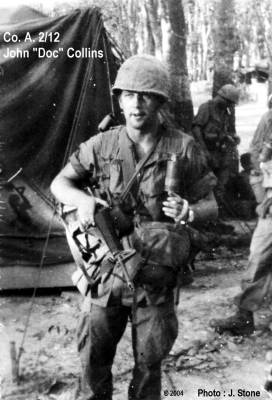
Photo 94. John “Doc” Collins
In an e-mail from John, I found that he was on the other side of the track during the shooting incident.
Additional Information From Dan Hollister:
I had sent a rough draft copy of this mission to Dan Hollister and he returned some very interesting information. Dan sent me a few additional photos that were taken on this mission. I couldn’t believe what Dan’s photos contained.
One photo of Dan’s is reported to be David Petrie (spelling?)(See photo 95) just after he was wounded with a booby trap on the road. I never knew Dave (see photo 96) was wounded on this road mission.


Photo 95. From the Holister Collection Photo 96. Dave- Taken at
Reported to be David Petry/Petrie (spelling?) base camp mess hall.
Photo number 97, of two tanks, may be part of the convoy ride back to Dau Tieng.
Another photo from Dan Hollister’s collection (see photo 98) shows the Baron, Engineers and other GI’s working the road.
Photo 99 is assumed to be the Baron with a minesweeper along side of the tank on the left.
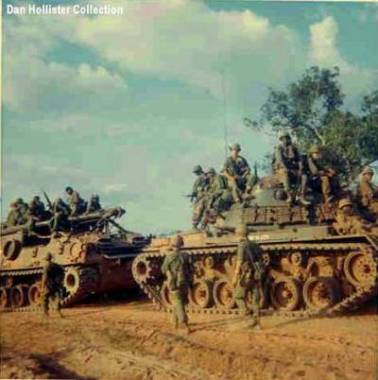
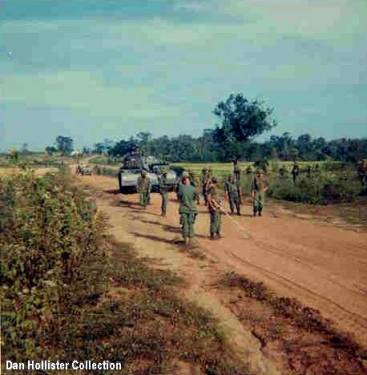
Photo 97. Hollister collection: Photo 98. Hollister Collection: Minesweepers on the road

Photo 99. Hollister Collection: The Baron
A photo of Dan’s (see photo 100) shows a different perspective of the dust off chopper that I had (See photo 62). This photo has the same bush that was in my photo, but another view of it. After re-examining my photos, I found another person in my dust off photo that I never spotted before. I can’t make out whom, but I can see his helmet at the lower right (see photo 63). This got me to realize I was not really alone in that open field like I thought I was. Some one was behind me. I have to assume, this man took this photo. Amazing!
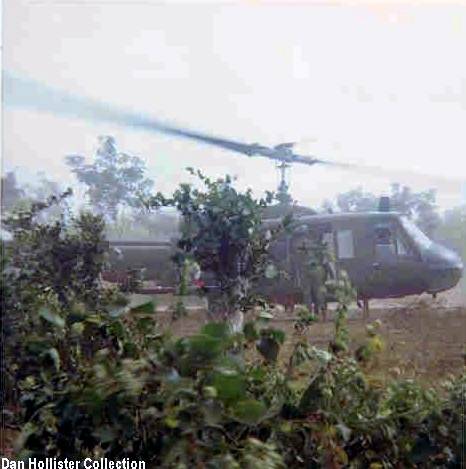
Photo 100. Hollister Collection: Medevac chopper.
Another photo (see photo 101) from Dan’s collection depicts a wounded GI getting carried on a stretcher to the chopper. This man on this stretcher may be Sgt. Draughon or the same casualty I photographed while we were both near the tank.

Photo 101. Hollister Collection: Evac after tank explosion
At first I thought Dan Hollister had taken the photos. He wrote back and reported that someone had given him the photos. I then became aware of the strong possibility the photos that Dan sent me were taken by the man behind me, in that field. I thought it was more than amazing that I was able to get these photos from Dan after 36 years had passed. [Thanks Dan]
Miscellaneous Mission Notes:
We had worked and traveled this road on many occasions but this particular mission only lasted for a few consecutive days. I had thought this mission lasted five days but my diary only accounts for three on this particular occasion. I thought we had received at least one casualty everyday but don’t have any listed for the first day, therefore I know I didn’t record all of the casualties. I vaguely remember on one of the days, possibly the last day, a booby trap went off on the right side of the road as we going out, injuring one or two men. Quite possibly this happened shortly after Sam Buffington was killed. It is quite vague but I do remember the Captain was upset, not only because of the injuries to the men, but because of the delay it had caused in our travel time. I believe it was during this delay I took the photo number 76 of Captain and Barney sitting at the side of the road. The photo also shows some of our guys standing on the road behind the Captain and Barney.
Quite possibly, one reason I thought that many were killed that night on Thunder Road, I went on R&R (Rest and Recuperation) in January. Those who were slightly wounded may have returned to the company while I was gone and by the time I got back, they were killed in subsequent missions. Many of the casualty dates corroborate this.
I am puzzled why I cannot remember if there was an actual artillery (arty) officer present on this road mission. It is quite possible there wasn’t one. I only noticed Captain Merrill using Barney’s radio during one call-in. I just don’t remember seeing Barney with any officer other than Captain Merrill. On subsequent missions, Barney carried the radio for Lieutenant (Martin) Beech (See photo 102) but I don’t believe Beech was assigned to the company quite yet.

Photo 102. Lieutenant Beech - Artillery Officer
There was an officer by the name of Deuchene / Duchenne /Deuchenne, (spelling?), and fairly sure he was an artillery officer, but I do not know if he was with us during the Thunder Road Mission. However, I am reasonably sure Deuchenne was assigned before Lt. Beech. I took a photo of him (See photo 103) in an LZ (landing zone) during a prior mission. His rank may have been Captain.
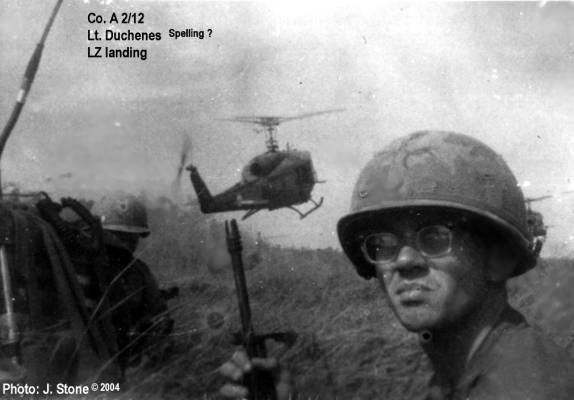
Photo 103. Deuchenne (spelling?)—Artillery Officer ?
Received from Charlie Page July 23, 2003:
John, You finally gave me the artillery officer’s name, Lt. Beech. I believe he was a great big guy and was a radio disc jockey at North Carolina State. His radio handle at NCS was "Dusty Dan." Quite a character -- A good guy.
—Charlie Page

Another officer that was present on this mission was Lt. Dean Walker platoon leader (see photo 104) taken sometime while walking the road.
I am fairly sure Sgt. Negron is in photo 44, standing on the right as the tank came out of the base camp. Quite possibly, the guy walking towards Harvey with the flashlight might have also been Sergeant Negron.
Photo 104. Lt. Dean Walker
On an out post guard duty one night in June or July of 1968 I ran into a guy said to be member of the 2/22nd Armored Division. We were just talking and the subject of the night on “Thunder Road” came up. The conversation was short and the content is vague, but this guy supposedly was on that track that fired on us. I had reason to doubt he was actually on the track, and also I think he wanted to be included in the well-known night on Thunder Road. I could be wrong in my reasoning.
I was told the track involved was also firing M-14’s and M-16’s at us, in addition to the fifty-caliber machine gun.
I sure would like to get in touch with my buddies from AIT that I saw on the tracks at the blown bridge. They would have a wealth of information. I do not remember their names. (See photo 87) And just out of curiosity, I always wondered what track they were on as they came down the road…Hmmmm?
For the record, I saved the fatigues I was wearing that night. I had them shipped home in my footlocker. While preparing this document I went to the garage attic to get the fatigues for a photo of the bullet holes and couldn’t locate them. Quite possibly forgot of the situation and what they meant to me and had worn them while painting cars.
Miscellaneous Events
I believe Lieutenant “Bobby” Bates was the next temporary appointed CO until a new one is assigned. (Photo 105) He is shown here from another mission with Sgt Harris.
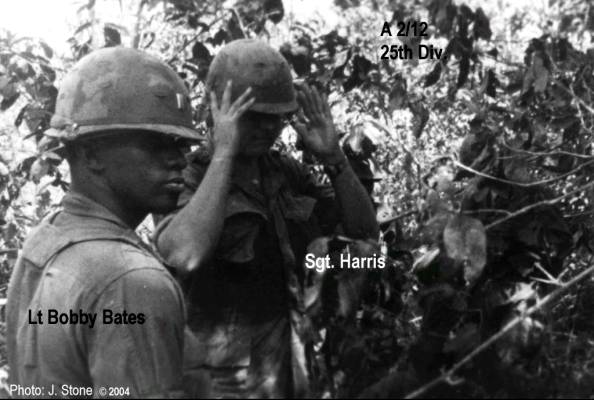
Photo 105. Lt. Bobby Bates and Sgt. Harris
Alpha Company’s next main commanding officer was Captain Lance Hewitt.
(Photo 106) Phot0 is from a future mission.
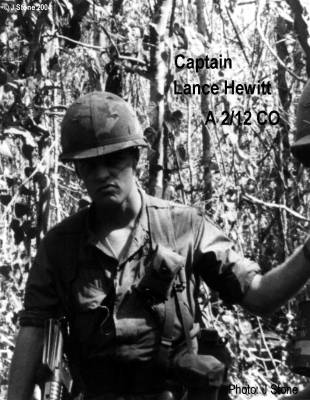
Photo 106. Captain Lance Hewitt
I will continue to try to get an updated company roster dated August, November and December of 1967 and any from 1968. They should prove to be very informative.
Miscellaneous E-mails
Received from Charlie Page, July 17, 2003
On the 31st of December the battalion was up at Katum and killed about 300 VC trying to overrun our huge firebase.
—Charlie Page
Corrections and additions welcome.
Because of the relevant information that any of this account may contain, I have included most everything I had collected, for those to ponder, add to, and edit. Whether you readers were present on this mission or not, I am 100 percent sure some Alpha Association members are going to spot something in this account or see something in one of the photos that you have information about. If you do, I sure would like to hear from you.
In a letter of Captain Smith’s, October 6, 2003, referring to some “blank spots” in some of the events we went through over in Nam—“ guess a lot of time, it is like a horse wearing blinders. You see what is in front of you but not what is on your right or left. The guy next to you sees that piece of the puzzle”
Captain Smith further explained —January 3, 2004…. That thought came home to me even more during the Alpha Association Reunion this past year. Each of us has a little piece of the puzzle. Talking to the guys, I learned things I had not known before.
—Captain Smith
As Captain Smith points out, your information just may be some of those “missing puzzle pieces”.
Acknowledgments
I send my sincere appreciation to the men of the Alpha Association for their generous information they have returned. Without their help, my diary would continue to lack many details that I have wanted to know for thirty-six years; and the fate of some of these men in this account would remain a mystery to me. I just hope the posting of this section of my diary and the photos will jog some memories, producing more details to these events and other experiences. I would like to thank, Charlie Page, Dan Hollister Jim Bison, Wayne Clark, Gary Barney, Andy Farris, John Collins, Ted Lawlor, Captain Smith and anyone else I may have forgotten to include; for their assistance of identifying men in some of my photos, the spelling of some names, their input and other information as to the fate of some of these men from “A “ Company. Occasionally I saw Bill Comeau’s, Jerry Virzi’s, and Pete Cullen’s name on some of the e-mails that were passed back and forth and forwarded. I can only try to express how much all of the contacts have meant to me. I look forward to continued correspondence and making new contacts as well. Thank you so much!
Thanks to my proofreaders for your help finding any errors I had overlooked so many times.
Thanks to Doug Huffman for allowing the use of his map.
http://www.users.qwest.net/~huffpapa/vietnam.html
Other very interesting web sites:
You can spend hours here— http://25thaviation.org
Things you never knew or forgot—Very interesting if you dig deep—see index.
http://www.no-quarter.org/gui/nq_codes.php —
http://vietnamwallexperience.com
Regrets
Above all, I send my deepest belated sympathies to the families and friends of the casualties mentioned and /or photographed in this account. My time spent with these men and the memories of these experiences would be lost forever if I don’t write these things down. Sharing this account and these photos is the least I can do to honor the injured and the men who paid the “Ultimate Price”.
My diary, photos and final mission continues…
I am very excited! I just got some news that “The Vietnam Wall Experience”, a Three quarter size replica of the Vietnam Memorial Wall, located in Washington, DC, is coming back to my hometown on the 9th of July of 2004. It will be set up in a park, just down my street, about one mile from my house. When I visit the Wall this time, I’ll be ready—more prepared and better organized than I ever thought was going to be possible, thanks to the guys in the Alpha Association. This trip I’ll have more time to visit, honor, and—to say good-bye to those who “gave all”. In the meantime, I will continue to prepare more of my diary, photos and data to share.
Thanks for taking the time to read this Thunder Road mission.
Take Care, John Stone
A closing note from my wife, Brooke:
John, congratulations on your work so far— I know there’s more to come. We’ve faced these demons together for 34 years, one at a time. As I‘ve always said,” I’ve never been to Vietnam, but I go there every day. Peace & courage.
Love, Brooke
Final Road Mission 1-A —partially edited version
Text, photos & waves —Copyright 2004 J. Stone